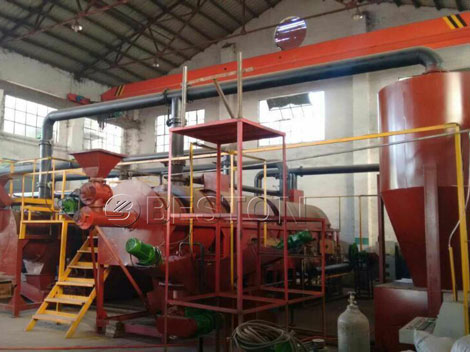How Making Charcoal From Biomass Helps To Reduce CO2 Emissions
While coal is certainly a cheap source of energy, it also has serious environmental impacts. Burning coal releases a lot of carbon to the atmosphere, improving the degrees of greenhouse gasses and accelerating the process of global warming. That is why, decreasing the carbon footprint of coal power plants is usually required by the us government, or may result in serious tax credits. Among the best means of accomplishing this is certainly coburning biochar with coal.
So what exactly is biochar? Biochar is created by making charcoal from biomass. Biomass is waste from living things, usually plants. Examples of good biomass for biochar include rice husks, leaves, hay, sawdust, lawn trimmings, and the like. Many industries, especially food industries, have plenty of cast off biomass, making biochar really cheap to produce. Within the developing world, biochar could be a very effective replacement for energy sources that need more industrial strategies to produce, like coal, natural gas, and oil.
To transform biomass into biochar briquettes, the substance must first be dried out. There are a number of competing methods for drying the biomass, but the most beneficial are carbonization and torrefaction. Torrefaction is performed at about 200-300 degrees Celsius, and produces a dry and inert substance. Carbonization, otherwise known as destructive distillation, is actually a chemical transformation comparable to how organic matter is transformed into fossil fuels like oil and coal naturally.
When the biomass has been dried out and rendered inert, meaning it will not spontaneously rot or otherwise decompose, it needs to be condensed into biochar briquettes. Based on the materials used and also the intended purpose, pretty much pressure is usually necessary to make the briquettes basically dense. Biomass from wheat and barely, for example, require quite high pressure, whereas corn biomass burns more efficiently if it is less compacted. Briquettes will also be often formed in a shape that permits for additional area, like a circle with more than one holes. Contact Beston Company for more info.
The result of this method of creating charcoal from biomass is biochar, which is certainly a efficient way of creating electricity without releasing a lot of greenhouse gasses. One of the most popular methods is coburning with coal. Coburning refers back to the practice of burning a couple of materials together. When burning coal and biochar together, the coal really helps to keep the furnace hot, as the biochar adds a lot of energy and produces less pollution per standard of heat. Biochar is typically cheaper than coal, but burns less efficiently. By mixing the 2 together, it is actually possible to make a furnace that costs less per watt of power generated and results in less pollution.
Biochar is a revolutionary method to utilize otherwise useless plant waste for energy. While coal is among the most pollution-heavy methods of producing energy, biochar can make it considerably less damaging for the environment. Coburning coal and biochar at the sametime is a terrific way to get the best from a coal power plant: www.carbonationmachine.net.
So what exactly is biochar? Biochar is created by making charcoal from biomass. Biomass is waste from living things, usually plants. Examples of good biomass for biochar include rice husks, leaves, hay, sawdust, lawn trimmings, and the like. Many industries, especially food industries, have plenty of cast off biomass, making biochar really cheap to produce. Within the developing world, biochar could be a very effective replacement for energy sources that need more industrial strategies to produce, like coal, natural gas, and oil.
 |
| Making Charcoal From Biomass |
To transform biomass into biochar briquettes, the substance must first be dried out. There are a number of competing methods for drying the biomass, but the most beneficial are carbonization and torrefaction. Torrefaction is performed at about 200-300 degrees Celsius, and produces a dry and inert substance. Carbonization, otherwise known as destructive distillation, is actually a chemical transformation comparable to how organic matter is transformed into fossil fuels like oil and coal naturally.
When the biomass has been dried out and rendered inert, meaning it will not spontaneously rot or otherwise decompose, it needs to be condensed into biochar briquettes. Based on the materials used and also the intended purpose, pretty much pressure is usually necessary to make the briquettes basically dense. Biomass from wheat and barely, for example, require quite high pressure, whereas corn biomass burns more efficiently if it is less compacted. Briquettes will also be often formed in a shape that permits for additional area, like a circle with more than one holes. Contact Beston Company for more info.
The result of this method of creating charcoal from biomass is biochar, which is certainly a efficient way of creating electricity without releasing a lot of greenhouse gasses. One of the most popular methods is coburning with coal. Coburning refers back to the practice of burning a couple of materials together. When burning coal and biochar together, the coal really helps to keep the furnace hot, as the biochar adds a lot of energy and produces less pollution per standard of heat. Biochar is typically cheaper than coal, but burns less efficiently. By mixing the 2 together, it is actually possible to make a furnace that costs less per watt of power generated and results in less pollution.
Biochar is a revolutionary method to utilize otherwise useless plant waste for energy. While coal is among the most pollution-heavy methods of producing energy, biochar can make it considerably less damaging for the environment. Coburning coal and biochar at the sametime is a terrific way to get the best from a coal power plant: www.carbonationmachine.net.


Comments
Post a Comment